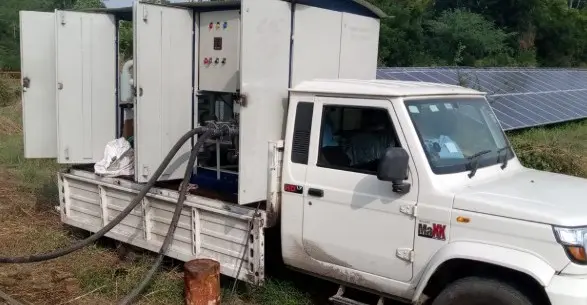
Meaning and Importance of Oil Filtration
Oil Filtration means the process of removing impurities present in oil.
This process is performed to keep the oil used in electrical equipment (such as transformers), engines, hydraulic systems, and machines clean and efficient. You can contact us for transformer oil filtration services.
Importance of Oil Filtration in Transformers
Oil Filtration in transformers is a highly important process.
Its main purpose is to keep the transformer oil pure and efficient.
Transformer oil is used for both insulation and cooling, so it must remain clean and free from moisture.
Purpose of Oil Filtration
-
To remove dust, water, metallic particles, and oxides from the oil.
-
To increase the dielectric strength of oil — helping it withstand electrical breakdowns.
-
To enhance the lifespan of machines and equipment.
-
To reduce maintenance costs.
What Does Transformer Oil Do?
-
Insulation: Keeps different high-voltage parts of the transformer electrically separated.
-
Cooling: Absorbs and dissipates the heat generated inside the transformer.
Why is Oil Filtration Needed?
Over time, transformer oil gets contaminated with:
• Dust
• Moisture
• Oxides
• Gases and carbon particles
These contaminants reduce the oil’s dielectric strength, increasing the risk of transformer breakdown or faults.
Oil Filtration Process (Technical Process)
The insulating oil used in transformers becomes contaminated with moisture, dust, gas, and other impurities over time.
This decreases its dielectric strength, making it more prone to breakdowns.
Hence, the Oil Filtration Process is carried out to purify and restore the oil’s efficiency.
Below is the complete technical process 👇
1. Preliminary Heating
• The oil is first heated to about 60°C–65°C.
• Heating helps remove moisture and gases present in the oil.
• An oil heater is used for this purpose.
2. Coarse Filtration
• In this stage, large dust particles and solid impurities are removed using filter paper or mesh filters.
• The oil becomes cleaner and ready for the next stage.
3. Fine Filtration
• In this stage, micro-level impurities (like carbon particles and sludge) are removed.
• Fine filter elements or cartridge filters are used for this process.
4. Vacuum Dehydration & Degassing
• The oil is transferred to a vacuum chamber.
• Under low pressure and high temperature, the oil releases:
• Moisture (water vapor)
• Dissolved gases
• Remaining impurities
• This process significantly improves the dielectric strength (BDV) of the oil.
5. Cooling and Circulation
• Once the oil is purified, it is cooled down.
• The clean oil is then filled back into the transformer.
• In some cases, this process is carried out on-load using a transformer oil circulation system.
6. Testing
• After filtration, the oil’s quality is tested.
• Common tests include:
• BDV Test (Breakdown Voltage Test)
• Moisture Content Test
• Acidity Test
• Interfacial Tension Test (IFT)
Main Equipment Used
- Oil Heater
- Vacuum Pump
- Filter Unit
- Oil Storage Tank
- Moisture Meter
- BDV Test Kit
Final Result
After filtration, the transformer oil:
• Gains higher BDV,
• Has reduced moisture and gas content, and
• Extends the transformer’s insulation life.
Advantages of Oil Filtration
- Increases the transformer’s lifespan.
- Improves the insulating quality of oil.
- Reduces the risk of breakdowns.
- Lowers maintenance costs.
- Enhances the overall efficiency of the transformer.
Summary
“Transformer oil filtration is a process that removes moisture, gases, and impurities from the oil, thereby increasing its dielectric strength — ensuring the transformer remains safe, efficient, and long-lasting.”
Click Here : Tan Delta Test-Meaning-Importance-Process and Advantages


